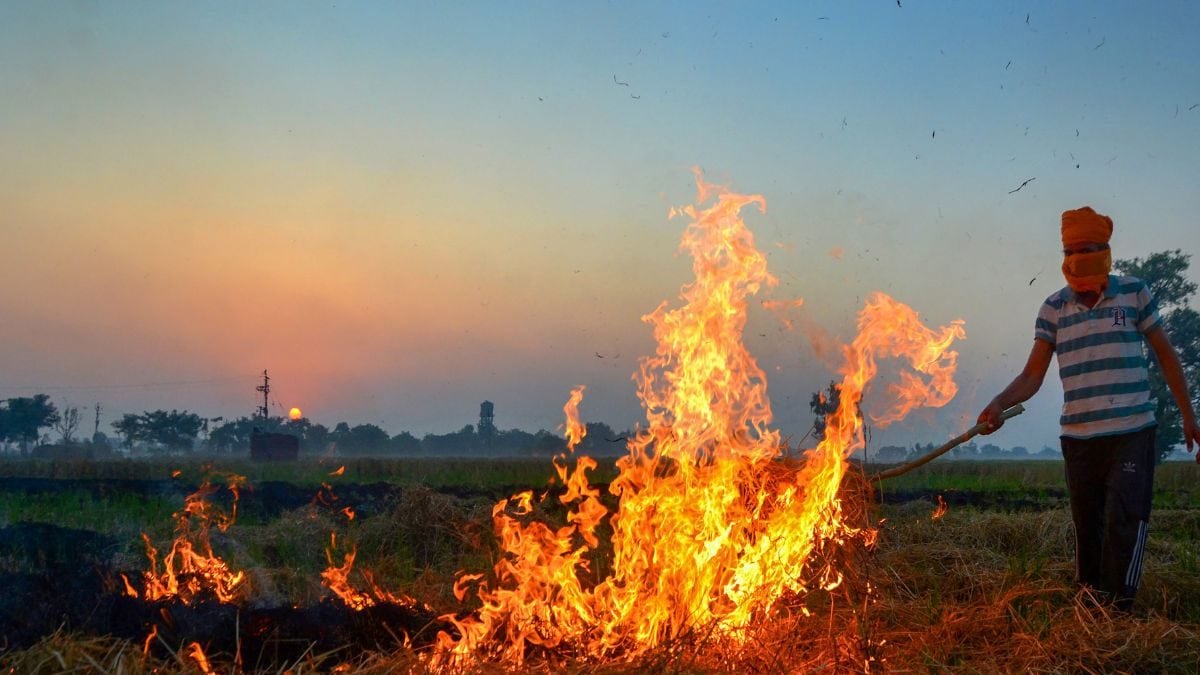A farmer burns stubble (parali) to remove paddy crop residues from a field on the outskirts of Amritsar, on November 2, 2023. (Photo: PTI)
Gufran Beig, Founder-Project Director of air quality monitoring system SAFAR, in an exclusive interview to News18 said the fire counts spiked suddenly after November 2, and the maximum smoke intrusion (PM2.5) from stubble burning occurred in Delhi on the night of November 2-3
The contribution of stubble burning to Delhi’s polluted air rose to nearly 44% on November 3, the highest this season, worsening the toxic smog across the national capital region. As the winds dropped, the huge amount of pollutants remained trapped deteriorating the air quality to severe levels for almost a week.
“The fire counts spiked suddenly after November 2, and the maximum smoke intrusion (PM2.5) from stubble burning occurred in Delhi on the night of November 2-3, and the day after. It has now come down to around 25% as the winds are calm, but the pollutants are now trapped,” said Gufran Beig, Founder-Project Director, SAFAR (System for Air Quality and Weather Forecasting and Research).
Speaking to News18 in an exclusive interview, the senior atmospheric scientist said the geographical location and climatology has proved to be bane for the landlocked Delhi. Unlike 2022, when the winds were higher due to change in global circulation patterns, the weather conditions have been extremely unfavourable this winter causing the winds to stagnate. “The intrusion of smoke from stubble burning happens at the transport level which is 500- 1,000 metres above the surface. When the winds are higher, this smoke moves towards Delhi creating a “tunnel-effect” as more pollutants get injected into it. The smaller-size pollutants like PM2.5 tend to stay air-borne for days and they get trapped as they reach Delhi due to stagnation,” he elaborated. Short-term exposure to PM2.5 is linked with increased risk of respiratory and other health problems.
WHAT IF IT RAINS? IMD PREDICTS DRIZZLE ON NOV 10
The India Meteorological Department (IMD)’s latest forecast of light rain/drizzle across North-western plains including Delhi around November 10 has further raised worries, as it may end up worsening the air quality. “A sufficient intensity of rain can wash away the pollutants. But if it drizzles in a few areas, then it will lead to secondary aerosol formation. The PM2.5 concentration tends to multiply as they cling to the water molecules suspended in the air, spiking up the pollution levels,” added the senior atmospheric scientist who is now a Chair Professor at the National Institute of Advanced Studies (NIAS), Bengaluru.
POLLUTION LEVELS TO SPIKE AROUND DIWALI?
With the Air Quality Index (AQI) hovering over 400, the latest air quality forecast suggests the pollution levels are likely to remain ‘very poor’ to severe over the next few days. The Stage Four of the Graded Response Action Plan (GRAP) has already been enforced. While there are slim chances of any improvement, the senior expert says there may be a ray of hope.
“The PM2.5 particles tend to remain air-borne for a few days. If there is no additional intrusion of smoke from outside Delhi over the next few days, and the fire counts are brought to less than 500-700 (threshold limit), then there could be some positive impact. But it can hold only when the weather conditions are favourable, and unfortunately that is not the case this time. The upper level wind direction and speed is not likely to change in the next few days. In fact, this is one of the longest spells where the wind direction and speed has remained constant over Delhi,” he said matter-of-factly.
DELHI POLLUTION: A MULTI-STATE PROBLEM
According to the senior scientist, the chronic winter pollution in the national capital is not just a Delhi issue, but a multi-state problem that requires concerted, sustained efforts from all neighbouring states. “We need to go beyond the territorial boundaries. All the mitigation measures that are implemented in Delhi, must be extended to the air shed region of Delhi, which stretches to about 100-150 km for it to have some impact,” he added.
Previous studies suggest that during fair-weather, 80% of Delhi’s pollution is caused by its local emissions and 20% from outside NCT. However, the contribution from external factors rises to 30-35% in winter. In terms of local emissions, 40% is caused by the ever-increasing transport sector, 17% by industries and 25% is re-suspended dust.
With Delhi struggling to breathe under the thick layer of toxic smog for almost a week, residents must try to restrict additional emissions and not add fuel to the fire. “Delhi is already vulnerable to air pollution due to calmer winds and lower temperatures, and we cannot do anything about it. But we need to look for a long-term solution which is backed by science,” he summed up.



